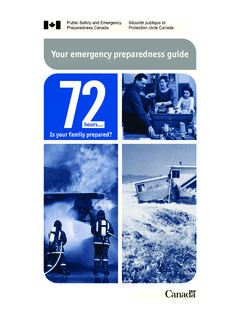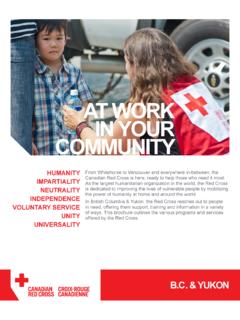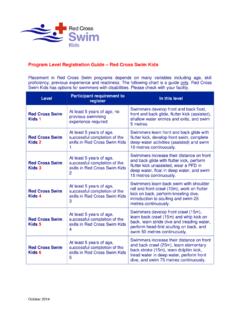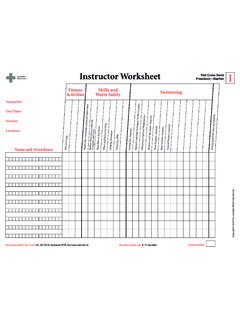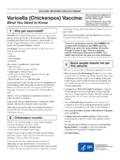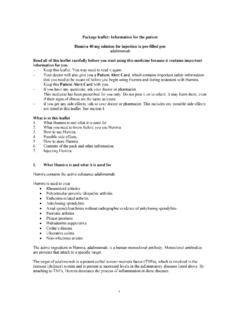Transcription of First Aid & CPR - Canadian Red Cross
1 First Aid & CPR Copyright 2017 The Canadian Red Cross SocietyAll rights reserved. No part of this publication may be reproduced, stored in a retrieval system, or transmitted, in any form or by any means electronic, mechanical, photocopying, recording, or otherwise without prior written permission from The Canadian Red Cross Canadian Red Cross Society (CRCS) has made reasonable efforts to ensure the contents of this publication are accurate and reflect the latest scientific research available on the topic as of the date published. The information contained in this publication may change as new scientific research becomes available. Certain techniques described in this publication are designed for use in lifesaving situations. However, the CRCS cannot guarantee that the use of such techniques will prevent personal injury or loss of publication is available in English and by Allison MacAlister | Photos by Matt Bork, Tara Hillyer, and Lisa PetrolePhoto Credits:ISBN: 978-1-58480-676-9 17 18 19 20 21 / 5 4 3 2 1 AcknowledgementsEach time a program is revised, it is built on the great work completed in the previous revisions.
2 The Canadian Red Cross would like to recognize everyone who worked on developing these programs in the past; their work set the foundation for our would like to thank our Training Partners, Master Instructor Trainers, Instructor Trainers, and Instructors who provided the feedback that helped guide this revision and shape our new revision required the hard work and dedication of many teams, who put in countless hours to contribute to its success. The Canadian Red Cross extends its thanks to the First Aid Technical Advisory Group (FATAG) for its overall leadership, dedication, and direction. FATAG members include:Dr. Andrew MacPherson (Medical Director)Jason BrinsonRichard CzechBlair DoyleJason DurhamDomenic FilippelliDr. Gordon GiesbrechtDr. Morgan HillierCarolyn HoekstraKevin HolderDr.
3 Loriann HynesLyle KarasiukSioban KennedyShelly LongmoreJodie MarshallRoger MayoKyle MohlerMichael NemethTyrone PowerBob ResideKathy SampsonMike SkinnerDiane StoryHugo SurprenantKristopher TharrisDebbie Van t KruisDave WooldridgeCharna YoungThe following organizations are pleased to support the important work of the Canadian Red Cross in developing this First Aid & CPR 37, bruise; Bidouze Page 57, child with medication; Thomas M PerkinsPage 58, car exhaust; Stefan_Redel/iStock/ThinkstockPage 59, poison oak; AllphinPage 59, poison sumac; 61, raccoon; bookguy/iStock/Thinkstock Page 61, black widow spider; KostichPage 61, brown recluse spider; SpencerPage 62, snake; Reptilia Zoo and Education CentrePage 63, sting ray; GuidoPage 63, anemone; The Vancouver AquariumPage 63, jellyfish; The Vancouver Aquarium1 The Red 42 Responding to Emergencies.
4 5 Preparing to Respond .. 5 First Aid Kit .. 5 Legal Issues .. 5 Chain of Survival Behaviours .. 6 After an Emergency .. 7 Lowering the Risk of Infection .. 8 Equipment Precautions .. 8 Removing Gloves .. 8 Handwashing .. 93 Check, Call, Care .. 10 Check .. 11 12 Call .. 13 Care .. 13 Recovery 14 Medication .. 14 Secondary Assessment .. 15 SAMPLE Questions .. 15 Vital Signs .. 15 Injury Check .. 15 Shock .. 174 Choking .. 18 Adult or Child .. 18 By Yourself .. 19 Baby .. 205 Circulation Emergencies .. 21 Heart Attack .. 21 22 Life-Threatening External Bleeding.
5 23 Applying a Tourniquet .. 24 Life-Threatening Internal Bleeding .. 256 CPR and AED .. 26 CPR .. 26 Compression-Only CPR .. 26 Adult or Child .. 27 Baby .. 28 When Rescue Breaths Don t Go 29 AED .. 307 Breathing Emergencies .. 31 31 Using an 32 Anaphylaxis .. 338 Wound Care .. 34 Bandaging 34 Cuts and Scrapes .. 34 Burns .. 35 Chemical Burns .. 36 Electrical 37 Bruises .. 37 Splinters .. 38 Nosebleeds .. 38 Knocked-Out Teeth .. 39 Eye Injuries .. 40 Impaled Objects .. 41 Chest Injuries .. 429 Head, Neck, and Spinal Injuries .. 43 Concussion .. 4410 Bone, Muscle, and Joint Injuries.
6 45 Splints and Slings .. 46 Regular Sling .. 47 Tube Sling .. 4811 Sudden Medical Emergencies .. 49 Diabetic 49 Seizures .. 50 Mental Health Crisis .. 51 Suicide .. 51 5212 Environmental Illness .. 53 Heat-Related Illnesses .. 53 Cold-Related Illnesses .. 55 Frostbite .. 55 Hypothermia .. 5613 Poisons .. 57 Carbon Monoxide Poisoning .. 58 Poison Ivy, Sumac, and Oak .. 59 Giant Hogweed and Wild Parsnip .. 59 Alcohol or Drugs .. 60 Insect Stings .. 60 Animal Bites .. 61 Spiders .. 61 Ticks .. 62 62 Stings from Marine Life .. 63 Foundations of First Aid .. 64 TABLE OF CONTENTSThe Fundamental PrinciplesHumanity: We serve people, but not : We care for the victims and the aggressors : We take initiatives, but never take : We bow to needs, but not Service: We work around the clock, but never for personal : We have many talents, but a single : We respect nations, but our work knows no Cross SymbolsThere are three official symbols (red Cross , red crescent, and red crystal) used to identify the International Red Cross and Red Crescent Movement.
7 These symbols are recognized around the world as signs of protection and neutrality. How We HelpThe Red Cross1 DISaSter MaNageMeNtSwIMMINg & water Safety PrograMINterNatIoNal oPeratIoNSreSPeCt eDUCatIoNfIrSt aID PrograMSCoMMUNIty HealtH aND wellNeSS4tHe reD CroSS5reSPoNDINg to eMergeNCIeS2 Responding to EmergenciesPreparing to RespondFirst Aid KitKeep a well-stocked and regularly inspected First aid kit in your home, car, and to ActSometimes people don t want to get involved in an emergency. The four most common reasons are:1. the Bystander effect: Someone else will look after the person. Never assume that someone will take action. Offer to help in any way you Unpleasant injuries or illnesses: That makes me feel sick! Close your eyes or turn away for a moment to calm yourself, then deal with the fear of catching a disease: I don t want to get sick!
8 Taking simple steps, such as wearing gloves, will limit the risk of catching a fear of doing something wrong or causing more harm: What if I make the person worse? The most harmful thing you can do is nothing at Issues Around First AidFirst Aiders must: Get permission, if possible, before giving care. Give only the care they were trained to provide. Continue giving care until another trained person takes over, they are too exhausted to continue, the scene becomes unsafe, or the person s condition improves and care is no longer Permission to HelpYou must get permission (consent) before giving care. For an unresponsive person, the law assumes you have permission. For a young child without a caregiver, provide care. If a person refuses care, call to Report Child Abuse or NeglectEvery adult in Canada has a legal duty to report child abuse or neglect, even if it is not confirmed.
9 Information around the specific how-to-report details can be found in your jurisdiction s child protection act, but the duty to report is uniform in all acts. If you think a child is being harmed, then a report to child protection and/or the police needs to occur. Chain of Survival BehavioursThe Chain of Survival Behaviours is a series of actions that, if integrated together, will help ensure a positive outcome for an ill or injured person. 6reSPoNDINg to eMergeNCIeSreSPoNDINg to eMergeNCIeS7 Your Role as a First Aider1. Recognize the emergency. 2. Protect yourself and Access help (one of the simplest and most important ways of providing First aid).4. Act according to your skills and Emergency Medical Services SystemThe emergency medical services (EMS) system is a network of community resources and trained personnel organized to give emergency care in cases of injury or sudden to Call EMS/9-1-1 Call EMS/9-1-1 if there is a danger to you or others or if a person: Is not easily accessible.
10 Is unresponsive or has an altered mental state. Is not breathing normally. Has persistent chest pain or pressure. Has life-threatening bleeding. Has a seizure. Has a head, neck, or spinal injury. Has an apparent mental health an EmergencyBeing involved in an emergency and providing First aid can be stressful. After the emergency is resolved, you may have lingering feelings such as uneasiness, doubt, anxiety, and fear. It is often helpful to talk to somebody about the situation. Consider seeking professional help (such as from your family doctor or mental health professional) if you experience any of the following for more than two weeks after the emergency: Crying fits or uncontrollable anger Trouble eating or sleeping Loss of engagement with former interests Feelings of guilt, helplessness, or hopelessness Avoiding family and friends Ignoring daily tasks, such as going to work8reSPoNDINg to eMergeNCIeSLowering the Risk of Infection Equipment Precautions Personal protective equipment ( PPE ) are items that protect you from contact with germs.

